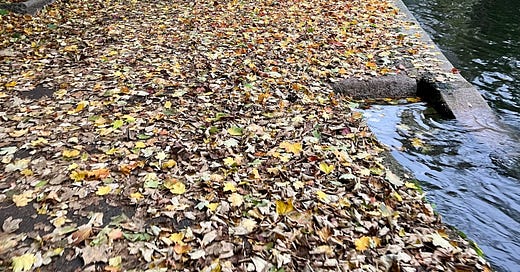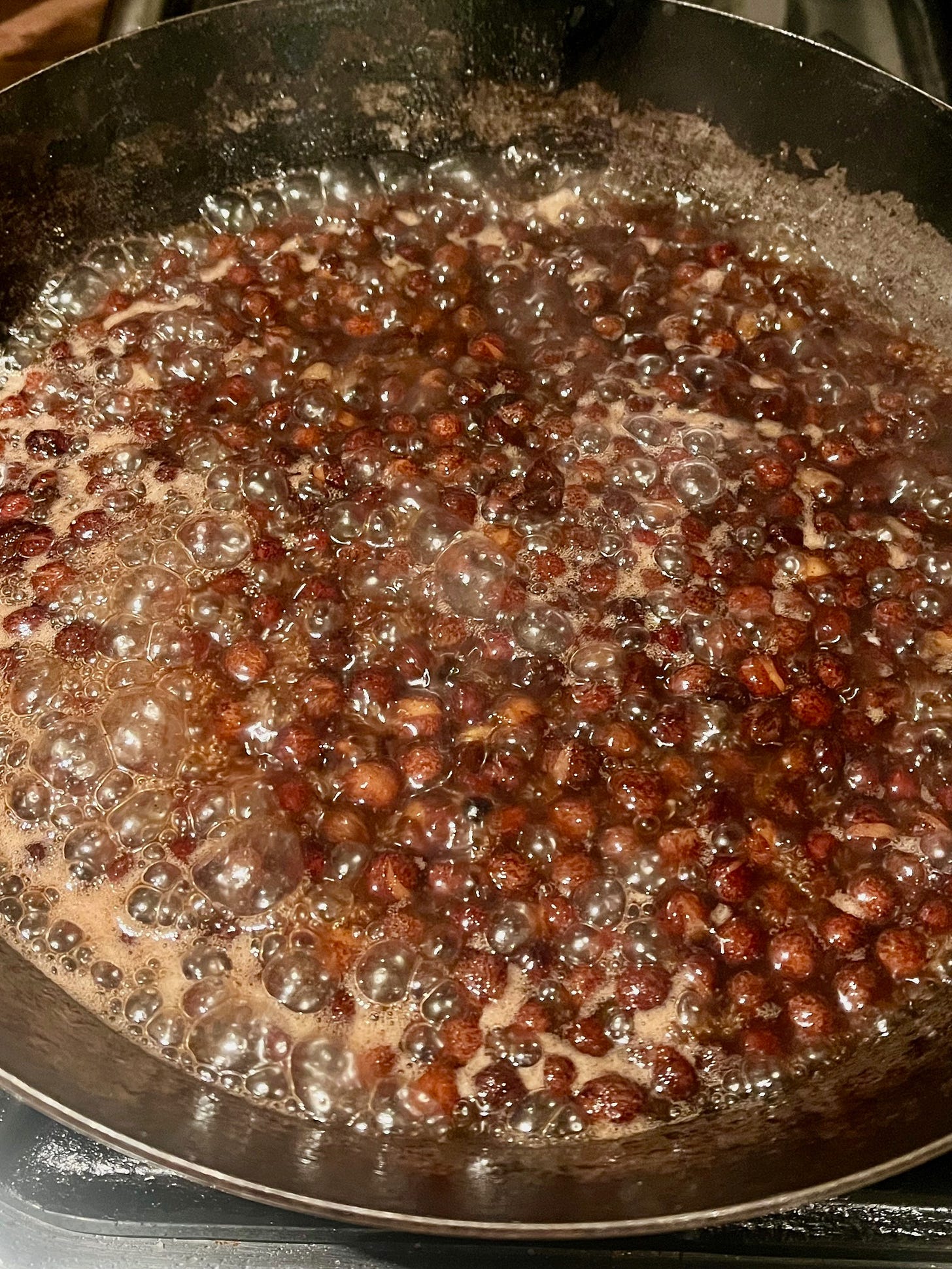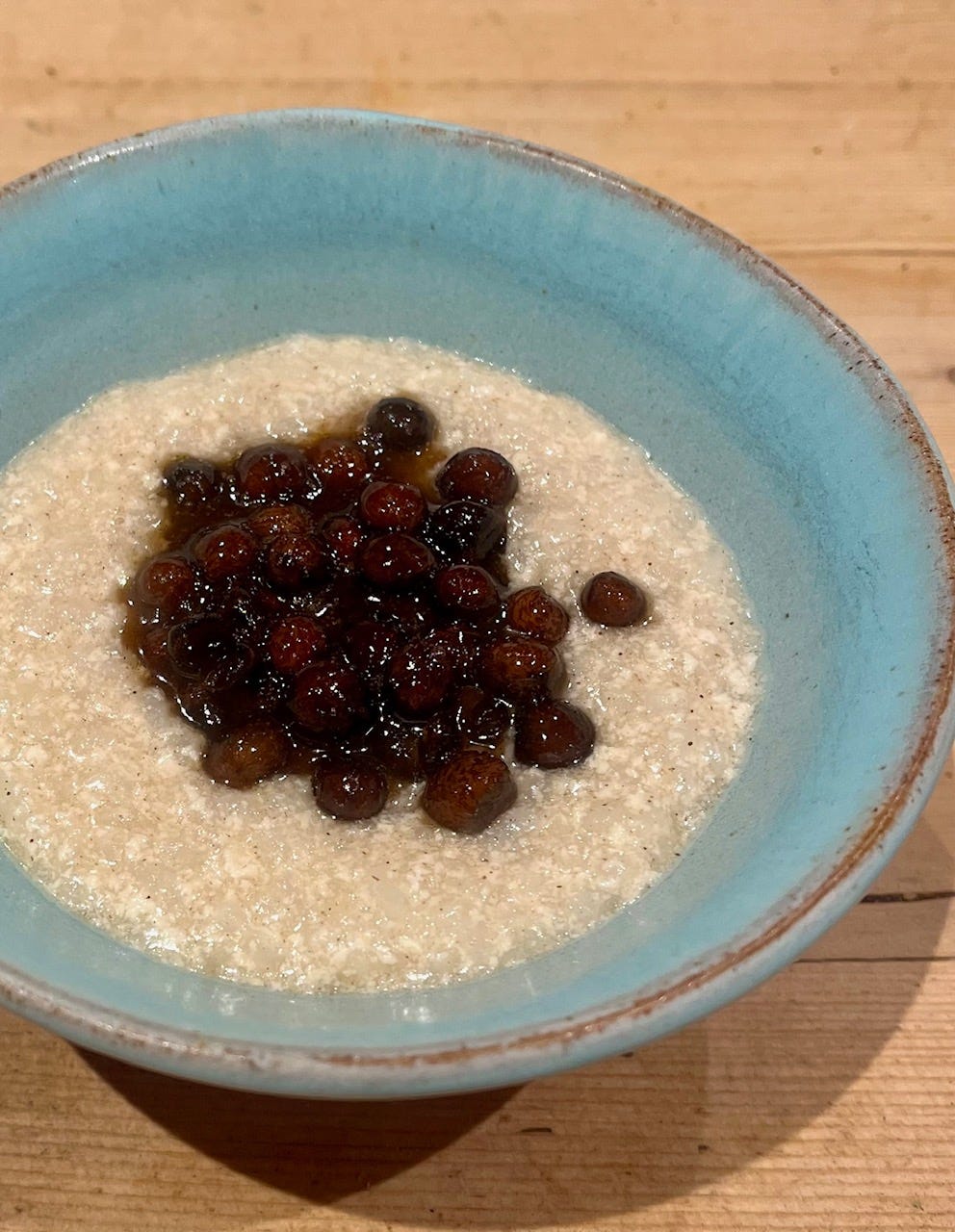I am up at 4.30, wishing it was light enough to go out for a walk, but it isn’t. No moonlight this morning, and no street lights where I walk and I don’t like wearing a head torch - a couple of the early morning dog walkers wear them and I think they are anti social as they always hit you directly in the eyes, blindingly. So I have made a batch of pancake batter which is a soothing thing to do first thing when you have peace in the kitchen. It’s a good time to bake, too, but I have a rule that I only bake things I can make without a stand mixer (I have a list) as I don’t want the noise.
The children’s lunches are made and I can’t read when I have a piece of writing to finish so here I am, trying not to think too much about what might unfold during the course of the next 24 hours and instead immersing myself in the cosiness of Bonfire Night food - jacket potatoes, pork and bean hot pots, enriched with mustard and treacle (it struck me recently that growing up, the heat in our food came from mustard, horseradish, black pepper, occasionally hot paprika. Never chilli peppers). Sausages with plenty of fried onions. Mulled cider and apple cake, sticky toffee apples, apple dumplings. It is of course apple season and a recipe for apple dumplings is coming here soon. Sticky gingerbread. Bread pudding. Treacle toffee. It all takes me back to my North Lincolnshire hamlet. Noisy colonies of rooks in the trees, the air a combination of woodsmoke, musty leaves and silage, as well as tempting, sometimes not so tempting whiffs of food from all the solid fuel ranges, pushed out through the chimneys instead of into the kitchens.
Last year I meant to write about the North of England tradition of serving carlin peas on Bonfire Night and was not organised enough to make some ahead of time and post a newsletter when it might have been of actual use to anyone. I did take a big batch to a neighbour’s bonfire party and once everyone got over their surprise at being served a brown chickpea type thing doused in salt and vinegar they vanished remarkably quickly. The one person there more northern than me had lived down south for several decades and was happy as he had totally forgotten about their existence. He talked about them being sold in pubs and in fairgrounds in enamel pots or paper cones - often on Carlin Sunday - the the fifth Sunday of Lent - as well as on November 5th.
The myths around the origins of the tradition are vague. They usually include a Captain Karlin who may have been Norwegian, French or Canadian. And he might have been saving the residents of Newcastle from near starvation when they were besieged by Robert the Bruce’s Scottish army in 1327 (apparently the peas were so sustaining they gave the Geordies enough vigour to fight off the Scots who transferred their attentions to Durham instead). Or he might have been supporting Newcastle when it was a Royalist stronghold during the Civil War in 1644 - apparently that siege lasted from February to the end of October. And there are many other stories too, all of which might have a kernel of truth in them but who knows?
Regardless, the new harvest of freshly dried carlin peas would always become available in October/November which works with the Bonfire Night tradition.
So tonight I will be serving them with salt and vinegar. BUT I had also read about a sweet version on the Hodmedod’s site - fried in butter and sugar and rum and thought I might try. More on this in a bit, but first….
How to cook Carlin Peas - AMENDED METHOD!
So earlier in the year I wrote this post about Carlin Peas and said that they cook EXACTLY like chickpeas which had up until that point been my experience.
However, I have had to revisit because the carlin peas I have bought recently have cooked much, much faster. In fact, one batch I cooked from soaked which had just 1 minute at high pressure and then left for an hour off the heat were mushy. I don’t know whether this is because they were fresher than those I was using last April - this is entirely possible - but it has made me amend my timings a little. If you are cooking them, use my shortest timings. It is perfectly safe to bring them briefly up to pressure again if they are still on the firm side.
This is my preferred method. You can of course cook them from unsoaked, but I would suggest that cooking from soaked, using either the quick or slow method of soaking, gives you more control and a better texture. Do not forget about the salt!
Soak the carlin peas in plenty of cold water with a teaspoon of salt, over night or for at least 3 hours, stirring every time you walk past them. OR quick soak. Put in the pressure cooker, cover with cold water and add a teaspoon of salt. Bring up to high pressure, cook for 2 minutes then remove from the heat and leave to stand for 5 minutes. Release any remaining pressure and drain.
You are now ready to cook them proper. Put in your pressure cooker, cover with cold water again and another teaspoon of salt. Add 1 tbsp fat or oil. Bring up to high pressure, cook for 1 minute then remove from the heat. Leave to stand for half an hour without opening - you will find the cooker will still be hot. Check the carlin peas - you should find that they are the tender side of al dente. Leaving them in the cooling water will continue to soften them so drain them bearing this in mind.
You can of course add aromatics to the cooking liquid. Remember that any whole spices will swell up and some will be hard to distinguish from the peas - I have learnt this to my cost with allspice berries. So a bouquet garni is a good idea.
Parched Peas
This is the classic version and you can of course be inventive with what you add to them. My kids go for the Tajin every time.
50g butter
500g cooked carlin peas
Malt Vinegar
Plenty of salt and pepper
Optional extras - dried or fresh herbs, crisp fried onions or shallots, spices, chilli flakes, citrus zest, have a play.
Melt the butter in a large pan and add the peas. Shake the peas around in the pan until glossy with the butter and starting to dry out. This is the way I like them - other people like to fry them then add some of the cooking liquor which thickens to a paste and will eventually dry around the peas if you cook them for long enough. If you prefer them this way, you can add a couple of ladlefuls once the peas have fried in the butter for a couple of minutes, then reduce. Then add plenty of malt vinegar, salt and pepper and keep tasting until you are happy with the flavour. Serve with more malt vinegar on the side.
Buttery Rum Carlin Peas
This does feel autumnal and warming, with the spices and brown sugar. I can imagine apple juice working really well with it too. Now, my son had a hankering for rice pudding and I had promised I would make it for him. And knowing full well that this might fall into the category of "just because you can, doesn’t mean you should”, I thought maybe I could try putting the buttery rum carlin peas with the rice pudding. Did I like it? Yes, I did, so did everyone else. Would I make it again? Probably - everyone in my house likes some kind of topping on their rice pudding and this takes no time at all if you have a batch of cooked carlin peas. I would prefer a fruit compote though. I’m not sure rice pudding has been put with carlin peas before but they are both very British and I think it works.
50g butter
50g light brown soft sugar
1/2 tsp ground cinnamon
1/2 tsp ground allspice
1/2 tsp ground ginger
250g cooked carlin peas
2-4 tbsp rum or similar (or a dessert wine for something less potent)
Melt the butter in a small frying pan, then stir in the sugar with a pinch of salt and the spices. When the sugar has dissolved, stir in the carlin peas and bring to the boil. Allow to bubble for a minute or two, then stir in half the alcohol. Bubble for a few moments, then taste and add more until you are happy with the flavour. Remove from the heat then allow to settle before serving as is, or with:
Brown Sugar Rice Pudding
You can use a mixture of sugar and maple syrup in place of the sugar, or just drizzle in a bit at the end. I used coconut cream because I do love coconut and rum together, but cream or some evaporated milk would also be good.
150g pudding rice
900ml whole milk
75g soft light brown sugar
3cm piece cinnamon stick
40g butter
100ml coconut cream (optional)
Put the rice, milk, sugar, cinnamon stick and butter into your pressure cooker with a pinch of salt. Close the lid and bring up to high pressure. Adjust the heat until it is just high enough to maintain the pressure, then cook for 15 minutes. Leave to drop pressure naturally. Open the lid and stir to bring everything together, then stir in the coconut cream if using. Remove the piece of cinnamon stick before serving, with or without the carlin peas. My son added some slices of mango too.
Thank you for reading! This is a free post so please do share with anyone who you think might appreciate it. And if you have enjoyed, please consider clicking through on the heart. I am told it really helps with visability. Thank you again!








What a lovely autumnal post, Catherine. Your allspice experience made me smile. Am very fond of carlin peas - had never thought of pairing them with rice pudding!
Hi Catherine, I just wanted to ask your advice please. I cooked some brown basmati rice in my pressure cooker, using plenty of water and cooked on high pressure for 8 mins (natural drop) as per your instructions in Modern Pressure Cooking (my bible! - can't wait to buy the new one!) and it was an absolute disaster! Total mush. What did I do wrong please? xx